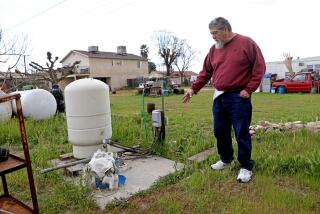California water officials deliver sobering facts on depleted wells
Just a few months ago, the state’s top water officials said they had reason for optimism. Rain was cascading down on California in December and water conservation passed 20%.
“I, for one, had high hopes,” Mark Cowin, director of the state Department of Water Resources, told a California Senate joint oversight hearing on the drought last week.
Cowin and his colleagues sat before lawmakers and took turns delivering a series of sobering facts and figures about the state’s persistent drought: The mountain snowpack was dismal; conservation is falling far short of Gov. Jerry Brown’s 25% mandate; officials are curtailing water rights.
One fact in particular caught senators’ attention, though. About 1,900 wells have gone dry, Cowin said.
“Should we be pushing a pause button on drilling deeper and deeper wells?” asked Sen. Fran Pavley (D-Agoura Hills), chairwoman of the Natural Resources and Water Committee.
As the drought persists and groundwater levels drop, thousands of Californians have been left without well water and some parts of the San Joaquin Valley are sinking. But with such a wide array of water concerns in the fourth year of drought, should Californians be alarmed about 1,900 dry wells?
Is 1,900 a lot?
The Department of Water Resources estimates that there are between 1 million and 2 million wells — either in use or idle — scattered throughout the state. On average, between 10,000 and 15,000 wells are added each year. Some are dug by hand, others are drilled to significant depths.
Therefore, 1,900 wells represents far less than 1% of the state’s wells.
Where are most of the dry wells located?
More than half of the dry wells are in Tulare County, southeast of Fresno, state officials said. Most of the dry wells there are within the community of East Porterville, where hundreds of residents have gone without running water and volunteers have delivered emergency supplies.
What does it all mean?
In much of the San Joaquin Valley, growers have been sucking more water from the ground than nature or man has put back for decades. But the overpumping has escalated during recent years of drought.
As water-starved Californians pump more from wells, groundwater levels decrease. Preliminary data from this spring show that over the course of the last year, the levels of more than 40% of the approximately 4,500 measured wells have declined more than 2 feet — not unusual for the fourth year of a drought, water officials said.
More concerning, the data show decreases of more than 10 feet in more than 15% of measured wells and some severe decreases of more than 25 feet in some central California wells. And state officials say several groundwater basins in the Central Coast and Southern California also show “significant to severe” levels of decline.
Groundwater provides close to 40% of the state’s water supply in an average year, and as much as 60% of supply in some regions during drought years, according to a 2014 state report. As the groundwater table drops ever lower, wells can become prohibitively expensive to drill.
Shallow wells go dry faster than deep, more expensive wells. Many such shallow wells are the sole source of water for residents and farmers who cannot afford to dig new wells when theirs run dry. The more than 1,000 dry wells in Tulare County supplied approximately 4,000 residents, state officials said.
When groundwater levels sink low enough, the soil can compact and cause the land surface to sink. Land subsidence can crack irrigation canals, buckle roads and permanently deplete water-storage space.
In some areas of the San Joaquin Valley, the land has been sinking as much as a foot a year. The Department of Water Resources expects to get a report next month that will help officials better understand the extent of subsidence.
Twitter: @ByMattStevens
More to Read
Start your day right
Sign up for Essential California for news, features and recommendations from the L.A. Times and beyond in your inbox six days a week.
You may occasionally receive promotional content from the Los Angeles Times.







